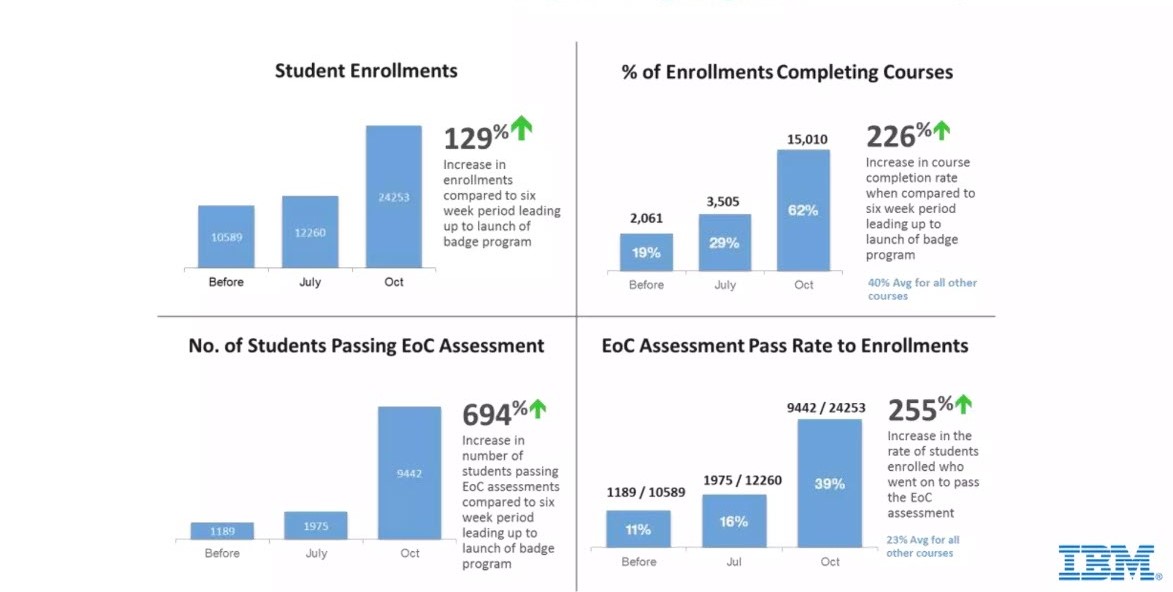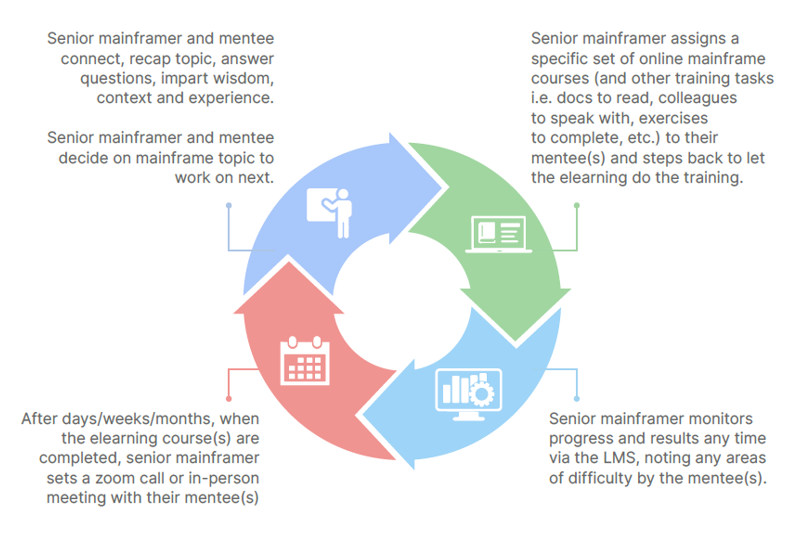With a shortage of mainframe-skilled university graduates available to replenish the modern mainframe workforce, mainframe organizations are ensuring long-term workforce vitality and efficacy by building internal talent pools. The synergy of succession planning, strategic upskilling, and internal mobility provides a powerful solution to a persistent mainframe industry challenge.
Upskilling Non-Mainframe IT Personnel To Expand Your Mainframe Workforce
Locating and hiring external college graduates and mainframe professionals is typically a difficult and costly task. A study by The Josh Bersin Company showed that it can cost as much as six times more to hire from the outside than to build from within.
One strategy for long-term success is to internally upskill the plentiful array of high-potential, non-mainframe IT employees — then move them, and their new mainframe skills, over to mainframe roles as needed. In this article, I outline three best practices your organization can utilize to build its own internal mainframe talent pool, as well as professional development strategies you can take to develop and upskill potential mainframe talent.
1. Identify Mainframe Talent Needs
Organizations should understand their current and long-term future mainframe talent needs based on business goals, retirement/attrition forecasts, and skills gaps. Utilize methods including workforce planning, talent mapping, and competency modeling to analyze the talent supply and demand. This will help determine critical mainframe roles, high demand skills, and which employees are ready or have the potential to move up or across the organization.
2. Identify High-potential Employees Who Aren’t Yet Mainframers
Identify employees in other IT departments who demonstrate qualities, skills, and attitudes that align with the mainframe organization's values and strategic goals. To identify these employees, you can utilize manager or mentor opinion, performance reviews, psychometric testing, and career conversations, which enable you to evaluate your employees' strengths, weaknesses, interests, aspirations, and potential for a mainframe career. Recognizing and acknowledging these employees will provide them with the motivation to invest further in their long-term professional growth and development toward a mainframe career.
3. Develop Your Mainframe Talent Pipeline
Now that your organization has identified a pool of high-potential programmers, DBA’s, security professionals, and systems administrators, it’s time to empower and inspire them. You must arm them with the mainframe skills and knowledge they need to excel in a mainframe career. You must inspire them to want a career on the world’s most consequential computer system and help them feel part of this remarkable global mainframe community.
Professional Development Components
Over the last decade, I have seen the following blend of professional development components prove highly successful for mainframe organizations developing mainframe talent pipelines. It keeps costs low, requires minimal work from mainframe managers, delivers superior mainframe skills, and inspires in employees a passion for mainframe work and a long-term mainframe career.
1. Easy-to-Access Mainframe Training
Providing a resource of year-round, on-demand, structured, online mainframe training is critical to upskill employees. These employees must have expansive mainframe training at their fingertips and be able to complete it on-demand — between and around their regular work. Having to wait for mainframe training or jump through hoops to get it increases the likelihood of potential future mainframers becoming disillusioned, losing interest, and not training as a result.
This mainframe training resource your organization chooses must provide clear, easy-to-follow learning paths based on the specific future mainframe roles available. It must begin with mainframe foundations, and progress through intermediate and then advanced mainframe skills. It must be scalable and globally deliverable, so it can be delivered to any number of potential mainframers, wherever they’re located. It must offer skills data reporting so the organization can easily analyze the overall mainframe talent pool and identify personnel with the skills needed for new and future mainframe positions.
This digital mainframe training resource is the heavy lifter, providing the bulk of the training at low cost, because for any mainframe organization, funding is often the hardest part.
2. Digital Credentials
IBM digital badges are the golden ticket for your mainframe professional development program. IBM digital badges motivate personnel to complete significantly higher amounts of training and achieve better training outcomes. Simply put, when developing an internal mainframe talent pipeline, half the battle is providing the mainframe training, and the other half is getting your employees to do the training.
A study of IBM employees showed that adding IBM digital badges to training created a triple digit growth across a broad range of training metrics.
With the addition of IBM badges, the number of IBM personnel actively seeking and enrolling in training increased by 129% and personnel completing their training courses increased by 226%. Additionally, personnel were more motivated to pass the end-of-course exam to earn the badge, as shown by an end-of-course pass rate increase of a stunning 694%.
Digital badges add many other benefits. The recognition that comes from earning a badge sees future mainframers more emotionally invested in their mainframe career and more connected with the global mainframe community.
Another study by the IBM Smarter Workforce Institute showed that the synergy of readily available mainframe training, and the recognition offered by IBM digital badges, delivered a staggering three times higher engagement at work and two times higher workforce retention.
Digital badges also provide your mainframe talent program with an objective source of skills truth. Your organization can be assured that employees who have earned an IBM badge truly possess the specified mainframe skills. Skills-based hiring depends on digital credentialing.
3. Skills Data
As your organization’s potential mainframe employees undertake more and more mainframe upskilling, your Learning Management System records data on all courses passed, exams passed, mainframe skills learned, IBM badges earned, proficiency, engagement, drive, commitment, and so much more. For mainframe workforce succession planning, mainframe organizations can use this skills data to look out one to five years and ensure there will be an optimally mainframe-skilled, internal IT employee available to fill available mainframe jobs. In the industry of big data, this mainframe skills data optimizes internal mobility from your internal mainframe talent pool.
4. Mainframe Coaching and Mentoring
Beyond any training, it is the decades of knowledge, wisdom, back stories, experience, culture, context, community, relationships, and system specific knowledge of your organization's senior mainframers that must be passed on pre-retirement, to the next generation of mainframers.

To facilitate this knowledge transfer, mainframe coaching and mentoring must be part of your mainframe talent pool development. As senior mainframers don’t have the time to be teachers, this mainframe coaching and mentoring is optimally achieved by utilizing the existing resource of online mainframe training to do the teaching.
Mainframe talent pool employees complete set courses, then the senior mainframer — armed with the insight of the training usage data — touches base once a month to recap, answer questions, advise, and set the mentee up with their next set of online mainframe courses and other training tasks (e.g., documents to read, colleagues to speak with, and exercises to complete). Rinse and repeat.
This low-cost, low senior mainframer effort method is the most successful way I have seen to facilitate mainframe knowledge transfer over an extended period.
5. Variety of Mainframe Training
Budget permitting, future mainframe professionals in your internal mainframe talent pool should attend a SHARE Conference! Nothing will get them more connected to the mainframe industry and the mainframe community than a few days of learning and networking at SHARE. Also budget permitting, your future mainframe professionals should attend an instructor-led training course on a specialist advanced topic related to their future mainframe job role.
For a low-cost mainframe training option, your internal mainframe talent pool’s future mainframers could job shadow experienced mainframe personnel or join cross-functional mainframe projects. Additionally, the IBM zDay virtual conference is free every year and very valuable.
Establish a Learning Culture and Measure Results
A learning culture is a set of organizational values, processes, and practices that encourage employees, and the organization, to continually learn and add new skills. Simply put, it's a shift from teaching employees to inspiring every individual to learn.
Speak with your learning and development leaders and discover how they are promoting learning culture at your organization. Key factors already include the copious training you are providing, and the recognition and reward of the IBM badges, and the internal mobility that shows your employees that hard work and passion will be rewarded by great careers and upward mobility!
A final key step is to monitor and measure your outcomes by tracking and evaluating your program. Use metrics such as retention rate, turnover rate, promotion rate, internal hire rate, time to fill, cost per hire, and employee satisfaction, to measure your program's effectiveness and impact. You can also use feedback surveys, focus groups, and interviews to collect qualitative data and insights from your employees and managers.
Your Mainframe Talent Pool Awaits
Your mainframe organization can only be as successful as the skilled, passionate team of mainframers that runs your mainframe. Locating and hiring external college graduates and mainframe professionals is difficult and expensive and may deliver mixed results. The recipe for long-term mainframe workforce success is to build an internal mainframe talent pool and take control of the process, from identifying high-potential IT employees, through their comprehensive internal mainframe skills training, and to the first day of their new mainframe careers.
Darren Surch is CEO of Interskill Learning, the world's most delivered and most IBM credentialed mainframe training. Darren is one of only two people IBM has ever named ‘Lifetime IBM Champion’ for IBM Z.